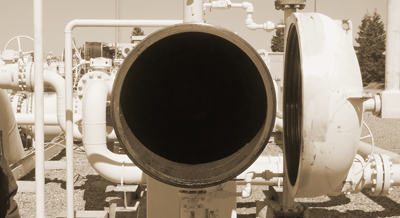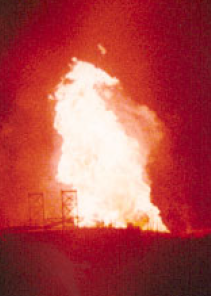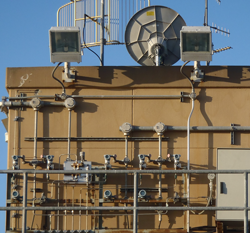
Article Background
This artcle was featured in the trade magazine "North American Oil & Gas Pipelines" during the March 2011 issue. Here are some highlights.
- A Prescription for Maintenance: Every effort should be made to protect a multi-million dollar pipeline investment...
- P for Prevention: The upfront cost of implementing a maintenance program in an effort to prevent deterioration...
- I for Integrity: Ensuring quality pipeline integrity can be accomplished...
- G for Goal: Obtaining real time data will help continuously monitor...
 J.R. Morgan - Sales ManagerWith over 19-years in the ILI industry, J.R. has plenty of knowledge and experience. So we feel he knows a few things and doesn't mind sharing. When J.R. is not hunting or enjoying the outdoors, he's passionate about managing diverse pipeline projects, planning integrity pigging programs for pipeline maintenance, preparing pipelines for in-line inspections, job costing and planning for the unpiggable pipeline. So we encourage you to challenge J.R's expertise - because were confident that what he doesn't know, he'll figure out.
J.R. Morgan - Sales ManagerWith over 19-years in the ILI industry, J.R. has plenty of knowledge and experience. So we feel he knows a few things and doesn't mind sharing. When J.R. is not hunting or enjoying the outdoors, he's passionate about managing diverse pipeline projects, planning integrity pigging programs for pipeline maintenance, preparing pipelines for in-line inspections, job costing and planning for the unpiggable pipeline. So we encourage you to challenge J.R's expertise - because were confident that what he doesn't know, he'll figure out.
- Download A Prescription for Maintenance
- Go to article at North American Oil & Gas Pipelines A Prescription for Maintenance
Routine Pigging Programs Keep Pipelines Healthy
Performing maintenance on both personal and business related assets is something we should all be familiar with. For example, homeowners perform preventive maintenance to ensure the living structure withstands nature's elements. Some of these measures include repainting the exterior, weather proofing the shell and using pesticides to shield against destructive insects, all to ensure the home's integrity does not decline.
In the same way, automobiles must also be maintained on a regular basis. Depending on the type of vehicle, most automobile manufacturers recommend changing the oil, rotating tires, servicing transmissions and flushing coolant fluids at certain mileage intervals during a car's lifetime. Each of these prescriptions should be performed in an attempt to protect and gain the most life out of your automobile.
We even perform maintenance on ourselves; the American Dental Association says to "brush your teeth twice a day."" Doctors prescribe certain amounts of exercise and recommend certain nutrition menus to help an individual person live the longest duration of life possible.
Therefore, with the aforementioned prescriptions for maintenance in mind, it stands to reason that every effort should be made to protect a multi-million dollar pipeline investment by prescribing routine maintenance pigging programs designed to guarantee pipeline longevity and optimum throughput. However, according to J. Cordell and H. Vanzant, authors of the Pipeline Pigging Handbook, "The required throughput must be obtained with the least capital investment and at the lowest operating costs."
The most advantageous way to maintain, protect and further the life of any pipeline is to establish and follow through with routine pigging programs. These programs entail running both mechanical cleaning pigs and digital in-line-inspection (ILI) pigs on a regular basis. It is also important to remember that no two pipelines are the same. Just because one pigging program works for a specific line does not mean it will produce the same results for another. The logic used to establish a pigging program on a pipeline remains the same but the applications often differ.
Using the acronym "P.I.G." (Prevention, Integrity, Goal), this article will provide three basic concepts of maintenance pigging to consider when determining how to establish and apply the right maintenance prescription for your specific pipeline.
Case Study: Pipeline Rupture and Fire

On Saturday, Aug. 19, 2000, a 30-in. natural gas transmission pipeline ruptured near Carlsbad, N.M. The released gas ignited and burned for 55 minutes. Twelve fatalities occurred, three vehicles were destroyed and two nearby bridges were damaged. Property and other damages or losses totaled $998,296, according to the National Transportation Safety Board's (NTSB) Pipeline Accident Report for the incident. Post accident investigation by the NTSB determined the cause of the rupture was "significant reduction in pipe wall thickness due to severe internal corrosion."
According to the NTSB's report, the subject pipeline was constructed in 1950, but sections of the line were not made piggable until the 1970s. Once launchers and receivers were installed at various locations along the pipeline system, pigs were then run approximately twice per year in an effort to remove liquids. However, there was no pig launcher or receiver that allowed pigs to be run through the section that ruptured. For that reason, and because of a reduced port valve and other pipeline features, including a drip, that portion of the pipeline (which included the rupture location) could not be pigged.
Post-accident analysis of pipe segments from the ruptured line section indicated considerable amounts of internal corrosion were present, which resulted in substantial metal loss. In contrast, in-line-inspections performed on line sections that were periodically pigged found no areas of metal loss that warranted repair by the company.
NTSB conclusions state, "If the accident section of pipeline had been able to accommodate cleaning pigs and if cleaning pigs had been used regularly with the resulting liquids and solids thoroughly removed from the pipeline after each pig run, the internal corrosion that developed in this section of pipe would have been less severe."
Similar case studies and ILI surveys have shown that pigging pipelines on a routine basis will play a crucial role in preventing catastrophes similar to the aforementioned rupture that took place near Carlsbad. Routine pigging will contribute to maintaining line integrity, will prevent and slow the spread of corrosion, will increase throughput and will have a direct connection to the overall safety of pipeline operations.
P for Prevention

Preventing foreign material from accumulating in the pipeline is a primary reason to pig on a regular basis. Foreign material includes, but is not limited to:
- Construction debris
- Sand and dirt
- Paraffin
- Liquids
- Iron Oxide
These are all typical types of materials that restrict flow and decrease the pipelines optimum efficiency. If left in the pipeline long enough these contaminants will gradually build up, increase in size and ultimately be a primary cause of internal corrosion.
Once corrosion starts in a pipeline it then becomes difficult for a pig to effectively clean the affected area due to pits created by the contaminant. When this occurs, the pigs cleaning elements (cups, discs and brushes) cannot effectively reach into the affected areas. Once this process begins the corrosion slowly spreads, causing an area of metal loss in the pipeline that will ultimately require attention, usually in the form of pipe replacement. Therefore, implementing an effective pigging program immediately following pipeline commissioning will aid in preventing these types of debris from accumulating in the line and will help to maintain optimum pipeline integrity and efficiency.
The upfront cost of implementing a maintenance program in an effort to prevent deterioration of the pipeline system will be more cost effective than the alternative of only running pigs on an "as needed" basis. If the assurance of maintaining a debris free pipeline that operates at maximum efficiency isn't enough reason to institute a preventive maintenance program, then perhaps the cost of lost time, lost production, lost revenue and repair costs that could easily surpass millions of dollars would be enough incentive to protect the very investment that creates the revenue it was meant to produce.
- Learn more about our cleaning equipment
I for Integrity
Integrity is one of the most common terms heard within the pipeline industry. The word is typically associated with pipeline inspection companies whose main purpose is to provide the pipeline owner with a detailed map of any given pipeline. However, the information sought after during an ILI is often dependent upon having a clean pipeline prior to launching an ILI tool.
For the pipeline operator who has invested the time and material required to maintain a pipeline system that is clean and ready for inspection, running an ILI tool will be practically trouble free. Good data is almost always collected and the ILI run typically goes smooth, without incident. These positive attributes are a direct result of establishing and maintaining a clean pipeline environment long before the ILI survey has been scheduled.
However, just the opposite can be expected of pipelines that have never or only rarely been pigged. When these types of situations arise, the contracted ILI company will typically require the running of several cleaning pigs through the pipeline in an effort to gauge the lines cleanliness, remove debris and prepare it for inspection. Often this leads to discovering the line is not ready for internal inspection because these types of spontaneous cleaning efforts often retrieve significant amounts of debris, which leads to additional and deliberate cleaning runs before the ILI can be accomplished.

These types of setbacks add extra days or sometimes weeks to the schedule and are typically never anticipated by the pipeline operator. This ultimately results in having to reschedule a multitude of events such as windows of opportunity with pipeline operations to run the ILI, arranging crews and equipment to be on site to handle the additional work load created by a dirty pipeline and even rescheduling the ILI company to come back at a later date. The end result is the unclean pipeline costs the pipeline owner additional money and lost time in production.
Ensuring quality pipeline integrity can be accomplished in many different ways and with many different pigs, ranging from cleaning pigs, geometry tools, crack detection tools, magnetic flux leakage (MFL) corrosion tools, video camera inspections and monitoring flow and pressure changes. But without maintaining a clean pipeline on a regular basis, some of these methods can give false information or not contribute any information at all until the pipeline has been sufficiently cleaned of the debris that may prevent these integrity verification methods from working to their full potential. This underscores the importance of instituting a routine pigging program in an effort to have your pipeline clean and ready at all times for emergency repairs and inspections that could arise at any given moment.
- Learn more about our integrity inline inspection equipment
G for Goal
Establishing goals is the result of focusing efforts to accomplish a certain achievement. In the realm of maintenance pigging, the goals could be many; each just as important as the next. For example, we've already discussed the concept of preventive maintenance and the importance of maintaining pipeline integrity. However, in addition to these goals, other primary goals should also be set.
Safe operating conditions during pigging campaigns can reduce adverse affects on the surrounding population and on the environment. This includes having the proper equipment on site during pigging, ensuring qualified personnel are available and having a contingency plan ready to put in place should an emergency situation arise.

Always ensure the proper pig configuration is being utilized for a specific application; making certain the cups, discs, brushes and magnets are properly sized and pig length is ideal for safely passing through known fittings in the pipeline.
Plan ahead to ensure the selected pig will obtain maximum effectiveness during each of its passes through the pipeline, so that it will help to maintain and even restore pipeline throughput to its highest potential or original level of flow.
Obtaining real time data will help continuously monitor the condition of any given pipeline. Having an awareness of known pig speeds for previous runs and how much time elapsed from launch to receive will help create a benchmark to judge future pig runs by. If a pig suddenly begins taking too much time to receive, that could be an indication of third party damage to the pipeline, a fitting that is out of specification or a change in running procedures - all of which are indications that should alert the pipeline operator that something has changed.
Having a rescue plan should a pig become stopped or lost in the pipeline is of utmost importance. This requires having a pig on site equipped with a transmitter designed to pass most restrictions and fittings to allow the tracking pig to run behind the initial pig so that it can be located. It is possible the tracking pig could hit the lodged pig, knock it loose and cause both pigs to travel on into the receiver. Nonetheless, the tracking pig should always be monitored at no more than one mile intervals using a minimum of two crews, both should always be equipped with the proper above ground locating equipment.
Making pipelines piggable should be an immediate goal during the construction phase of any pipeline. The ability to pig a line on a regular basis can prove to be of great value and will help slow or prevent the formation of corrosion cells. Every pipeline, regardless of its age or location should be equipped with launchers and receivers at the very minimum. With advancements in pigging technology, pigs can now be designed for most any application and can now pass through most types of fittings that pipeline companies would not have considered pigging through just a few short years ago.
Maintaining an effective record keeping system during pigging will also prove to be beneficial in determining issues such as cost per pig run, documenting improved flow rates and pressure changes. These records will also be an excellent source to revert back to if future problems arise. Detailed log books also serve as good evidence of maintenance pigging that can be provided to an ILI company prior to an inspection.
Having a constant awareness for maintaining pipeline integrity is a fundamental aspect of pipeline pigging. Adherence to maintenance pigging will result in nothing less than optimum efficiency, prolonged life of the pipeline and will provide safer operating conditions of the commodity being transported. Applying the P.I.G. philosophy to your daily pipeline routine can help the pipeline owner achieve this goal, making sure everyone comes out a winner.

